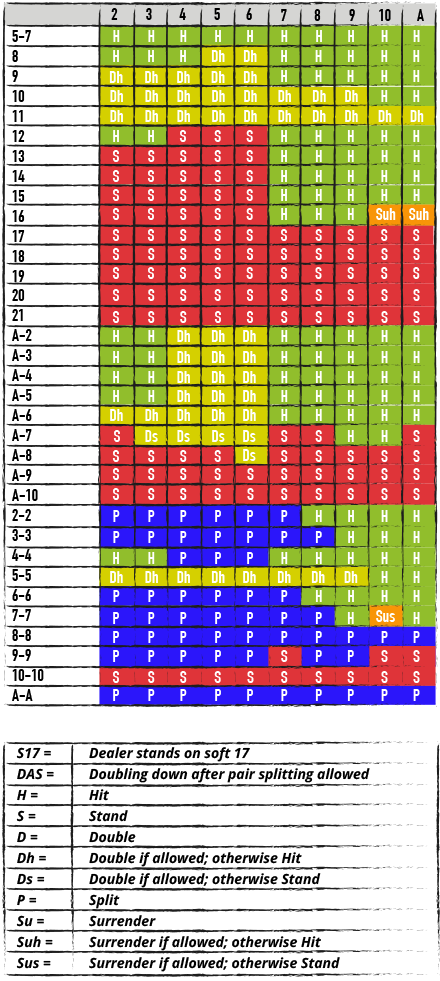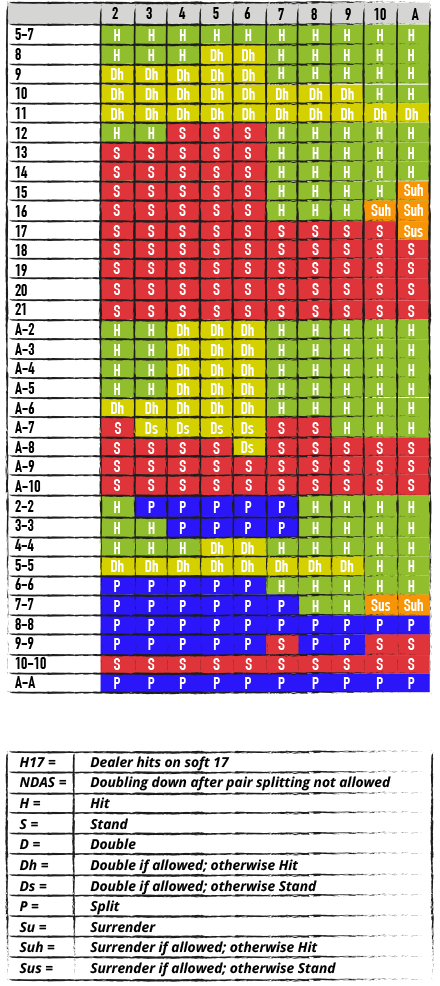Single Deck Blackjack Strategy Table
- Single Deck Blackjack Strategy Table Blackjack
- Single Deck Blackjack Strategy Table Game
- Single Deck Blackjack Strategy Tables
- Single Deck Blackjack Strategy Table Examples
20.05.2020, 16:28
The table below shows Wizard of Odds's composition dependent exceptions to single-deck blackjack basic strategy, using Boss Media rules. Cryptologic and Microgaming composition dependent exceptions follow. 3 – DO Play in Single Deck Games When You Can. Blackjack is a game with a low house edge—that’s just the mathematical advantage that the casino has over the player. But different blackjack games have different conditions. One of those conditions is the number of decks in use. The rule of thumb for the player is simple. For example, they’ll offer single-deck tables with 6:5 natural blackjack payouts. A single deck reduces the house edge by 0.59% when compared to the common 8-deck games. However, the 6:5 natural payouts boost the house advantage by 1.39% compared to 3:2 payoffs. The following strategy charts are designed for single deck blackjack. Before you begin using these charts, make sure that you are playing in a single deck game. These charts slightly vary for optimum performance on a game to game basis. Action: H = Hit S = Stand D = Double P = Split.
Blackjack is a card game, in which the player aims to beat the dealer’s hand without going over 21. Technically, any amount of card decks can be used in a game of blackjack. Casino blackjack games are played most often with six to eight decks.
However, you can find tables using anywhere from one to eight decks. In this guide, we will teach you the best blackjack single deck strategies.
Multi Deck vs Single Deck Blackjack
First, let’s look at the difference between single and multiple deck blackjack games. When playing with a single deck, a player will hit blackjack approximately once every 20.72 hands. With a two-deck game, the rate increases to once every 20.93 hands.
For four decks, it is once every 21.02 hands, and six-decks correlates with once every 21.07 hands. The payout will change as well, depending on whether you use a single deck or multiple decks. For instance, many casinos offer 6:5 payouts for single-deck games, but 3:2 payouts for multi-deck games.
Let’s give this a practical application. Let’s say that you have $10 that you’d like to wager. If you play a 3:2 multiple deck blackjack game and won the round, you would win $15. However, if you instead chose to wager $10 on a 6:5 single-deck blackjack game, you would only win $12.
Essentially, you are losing out on $3 each time you hit blackjack. Plus, if you place a wager that isn’t divisible by $5 then your returns will be even worse.
Utilizing a 3:2 payout, here is the house edge for different numbers of decks:
On the other hand, this is the house edge for a 6:5 payout:
Does this mean that you should avoid playing single-deck blackjack altogether? Definitely not! There are some casinos that have done away with the 3:2 payout model and only employ 6:5.
If this is the case, you should try to play a single game since it will have the lowest house edge. So, let’s take a look at blackjack strategies for single-deck games.
The Basic Strategy for Blackjack Single Deck Games
Let’s start off with the blackjack basic strategy for single-deck games. We have two single deck blackjack strategy charts for you: one is for when the dealer hits on soft 17, and the other is when he stands. To use the chart, you will look at your hand on the left vertical edge and at the dealer’s card along the top. Find the intersection point of the column and the row.
If the square says H, you should hit. If the square says S, you should stand. For D, you should double if allowed – and if not, then hit. Similarly, double if allowed if your square says Ds.

If not allowed, then stand.
If the square says P, you should split. If you are allowed to double after splitting, then you should split for H/P, D/P, and S/P. If not, then you should hit, double, and stand, respectively.
If the square says H/R, then surrender (or if not allowed, hit). Similarly, for S/R, surrender if you are allowed, or otherwise stand.
Now that we’ve taken a look at the single deck blackjack basic strategy, let’s go through some other methods you can use to improve your chances of winning.
Card Counting
Another useful single deck blackjack strategy is card counting. You can count cards no matter how many decks the dealer uses, but there are some differences in a single deck vs. a multiple deck game. In a multiple deck game, players starting hands will be dealt face up. In a single deck game, however, players will receive their two first cards face-down.
If you are accustomed to card counting during multi-deck games, this change may be a little difficult to get used to. However, the main principle of card counting remains the same. You will establish a running count and then add or take away the value of each visible dealt card.
There are two schools of thought regarding the true count in a single-deck game. In multi-deck games, a player would establish the true count by dividing the running count by the total number of remaining decks. So, some players do not establish a true count during a single-deck game. This certainly makes the card-counting process simpler but not necessarily more accurate.
Some people decide to alter the true count calculation method to improve their odds in a single count game. Rather than dividing by 1, some people count the number of hands and multiply that figure by 2.7. Then, they subtract the result from 52.
That number is what you divide into the running count in order to establish the true count. However, this requires very quick thinking and strong mental math skills since you are multiplying and dividing decimals.
Yet other players estimate how much of the single deck is left and divide that number into the true count. For instance, if the running count is 2 and there is ½ of the deck left, then you would multiply 2*1/2 to get 4. This method is more accurate than ignoring the running count altogether, but also much simpler than multiplying hands by 2.7.
So, decide whether you want to establish a true count, and what method you will use to do so.
Here are some various card counting strategies you can use while playing a single-deck game of blackjack:
Hi-Opt 1
While the Hi/Lo card counting method works great for multi-deck games, Hi-Opt 1 is better for single-deck games. It has a betting correlation of .88 and is a level I strategy, meaning that it is quite simple. In this strategy, you would count cards 3-6 as +1, 2,7,8,9, and Ace as 0, and 10 as -1. It may also be beneficial to run a side count of aces.
If a quarter of the deck has been played, but no aces have yet been dealt, then you know that the rest of the deck is “rich” one ace. So, for betting purposes, you can temporarily add +1 to the running count. Conversely, if 2 aces have come out of the quarter-deck, you can adjust the running count by -1.
Hi-Opt I has a betting correlation of
Hi-Opt II
As the name suggests, Hi-Opt II is a little more complex than Hi-Opt I, but it has slightly more accurate results with a .91 betting correlation. It was developed for single decks but can also be used in a multi-deck game. Many experts believe that Hi-Opt II will not work properly unless you keep a side count of Aces, so be sure to do that.
With Hi-Opt II, 2,3,6, and 6 have a value of +1. 4 and 5 have a value of +2, while 8, 9, and Ace have a value of 0. 10 has a value of -2. You have more values to keep track of, which is what makes it more complex than Hi-Opt I.
What to Bet

Single Deck Blackjack Strategy Table Blackjack
So now that you have established a running count, and possibly a true count, what should you bet? Well, one method you could follow is the MIT betting strategy: Amount to Bet = (True Count – 1) * Betting Unit.
Let’s say you are playing at a table with a $5 minimum and a $25 betting unit. Here is a guide to what you would bet, depending on your true count:
0 or less: bet $5
+1: bet $5
+2: bet $25
+3: bet $50
Now, what if you don’t have that kind of bankroll to support those bets? Well, according to the Kelly Criterion, a player should take a look at their advantage and then bet the same percentage of their bankroll. Let’s say that a player has a bankroll of $1,000.
If the true count shows that the player has a 1% advantage, for instance, then the player should bet 1% of $1000, or $10. If their bankroll was only $300, then the bet should be $3. This method should maximize the player’s profits while simultaneously minimizing their risk.
Another blackjack betting system is the Martingale strategy. With this, you don’t take your running count into consideration when placing your bets. Rather, you double your previous wager for every losing bet that you make. Then, when you have a win, you go back down to the minimum wager.
The mathematics of the system show that you would have an overall profit of your starting stake. For instance, if your first bet is $5, then you would net a total profit of $5. This would be a good betting system to use if you don’t want to bother with card counting. Martingale’s downside is that it typically requires a large bankroll because you have to outlast potential losing streaks.
Additional Tips for Single Deck Blackjack
Single Deck Blackjack Strategy Table Game
These tips will help you become proficient at playing single-deck blackjack, but you can also apply them to multi-deck games.
- Start with Small Stakes: When you are still learning how to count cards, it is best to keep the stakes low. Look for $5 minimum tables, or even lower if such tables are available. Use this opportunity to master your skills before moving on to tables with higher stakes.
- Stay Aware of Your Bankroll: This is especially important if you are going to use Martingale or another progressive betting strategy. Running out of money mid-losing streak would be very unfortunate.
- Be Subtle About Card-Counting: Casinos reserve the right to refuse to let you play a game, or to kick you out of the venue altogether. They might do so if they suspect you of counting cards, so don’t be blatant about your techniques. Furthermore, don’t forget to take breaks! If you sit down and play for hours upon hours, this will garner some suspicion.
- Practice Mental Math: Practicing counting cards at home can be simple enough. However, at a casino, things can get a little hectic. You need to be sure that you can count cards efficiently and ignore distractions.
Now that you’ve added some strategies and tips to your arsenal, go ahead and give single-deck blackjack a try! At Bob Casino, you can play for fun or for real money. Why not both? Practice your skills for fun, and then, once you have mastered your counting strategies, play for money. Join Bob Casino to have a great time playing single-deck blackjack!
Single Deck Blackjack Strategy Tables
Single Deck Blackjack Strategy Table Examples
Source article:
Top Single Deck Blackjack Strategies